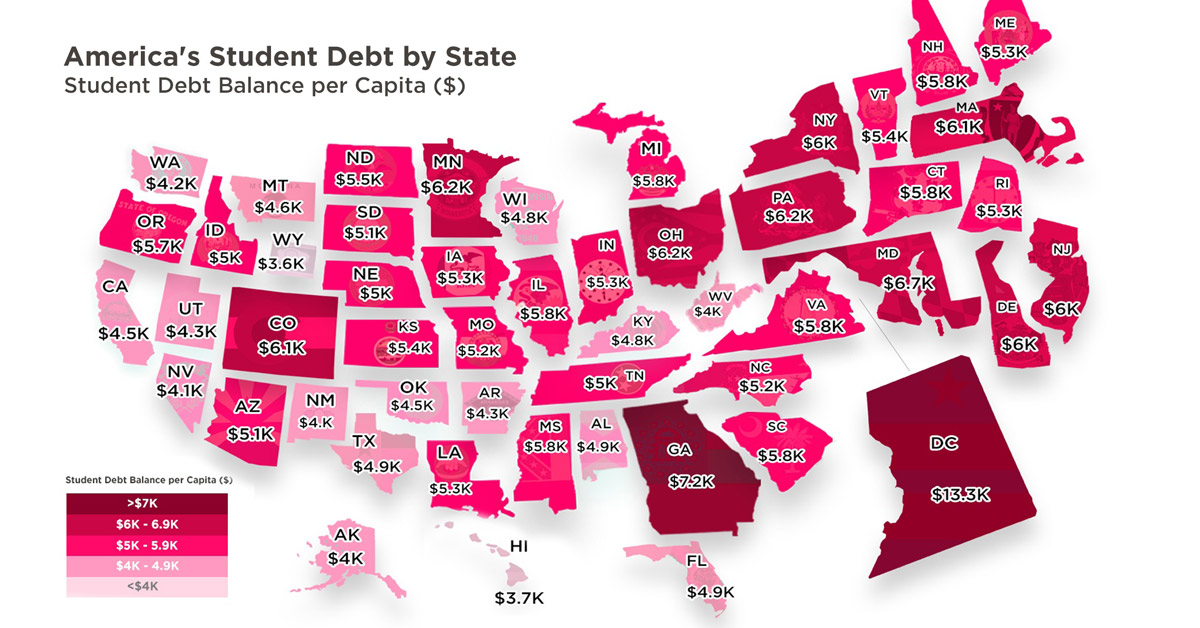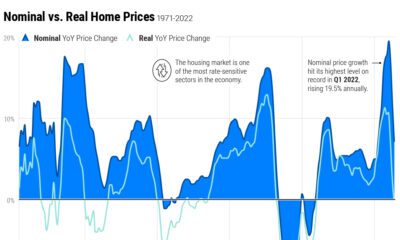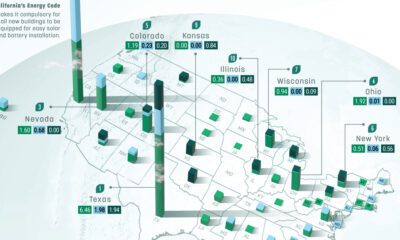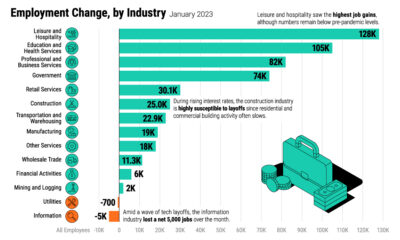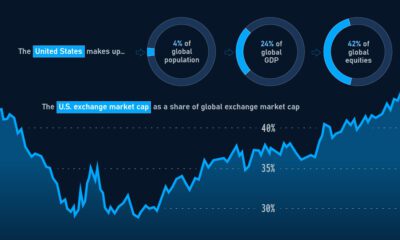Debt
How Much Student Debt Does Each State Hold?
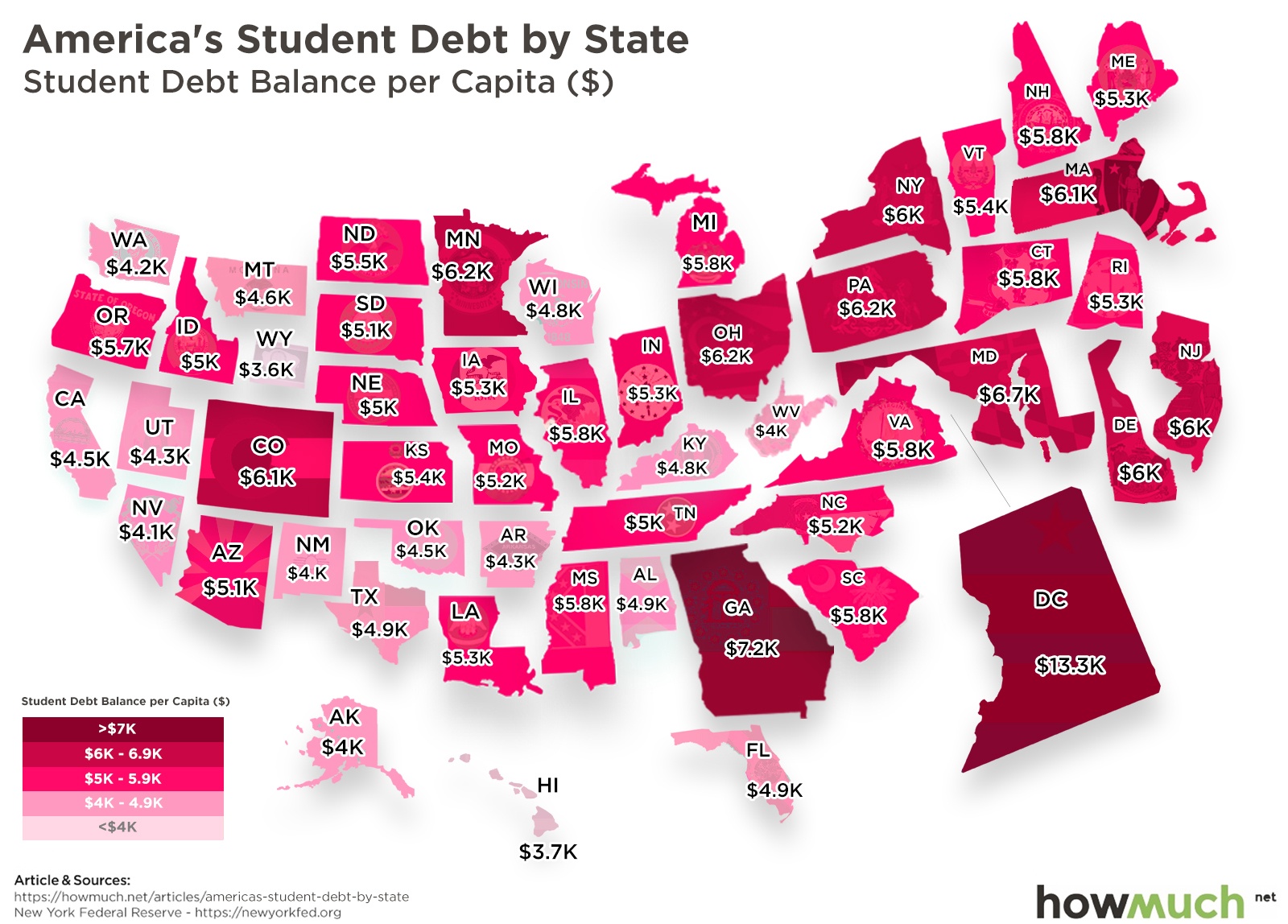
How Much Student Debt Does Each State Hold?
Education may be priceless, but the costs of obtaining it are becoming steeper by the day.
Almost half of all university-educated Americans rely on loans to pay for their higher education, with very few graduating debt-free. Total U.S. student debt has more than doubled in the last decade—reaching a record high of $1.5 trillion today.
Today’s data visualization from HowMuch.net breaks down the average student debt per capita, to uncover which states shoulder the highest burden in this growing crisis.
Students are Paying Through the Nose
Before diving into the graphic, let’s take a quick look at why student debt is racking up. The ballooning costs to attend college today compared to thirty years ago is one driving factor.
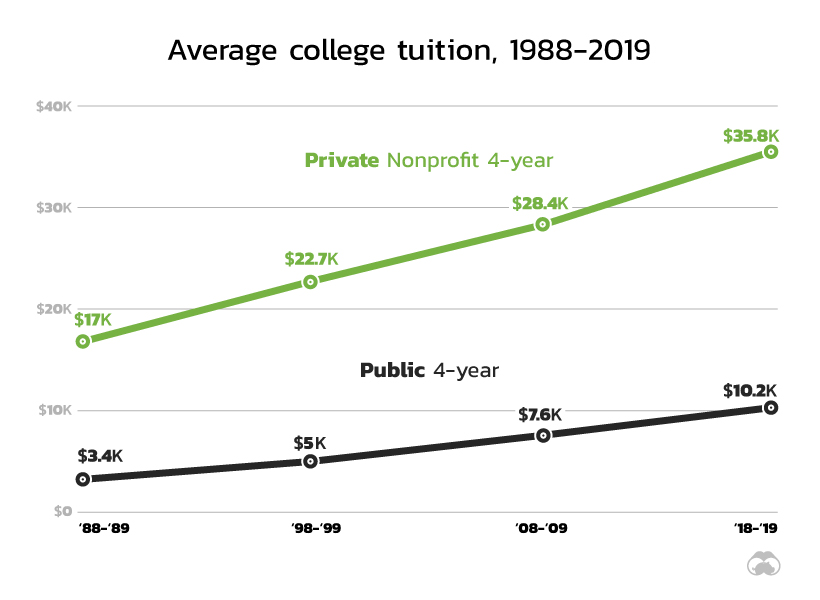
Source: The College Board 2018 report.
What’s more, these figures don’t include the expenses for accommodation and other supplies, which can add another $15,000-$17,000 per year.
The United States of Student Debt
In the state map above, it’s immediately obvious that Washington D.C. tops the list. While the nation’s capital is the most educated metropolitan area in the country, it also suffers from $13,320 in student debt per capita.
At approximately 147% above than the national average of $5,390, Washington D.C.’s debt burden per capita is almost double that of the state in second place. Georgia comes in with $7,250 debt per capita, 34.5% above the national average.
| State | Student Debt per Capita | Difference from Average |
|---|---|---|
| Alabama | $4,920 | -8.7% |
| Alaska | $4,030 | -25.2% |
| Arizona | $5,170 | -4.1% |
| Arkansas | $4,330 | -19.7% |
| California | $4,530 | -16.0% |
| Colorado | $6,180 | 14.7% |
| Connecticut | $5,890 | 9.3% |
| Delaware | $6,040 | 12.1% |
| District Of Columbia | $13,320 | 147.1% |
| Florida | $4,940 | -8.3% |
| Georgia | $7,250 | 34.5% |
| Hawaii | $3,780 | -29.9% |
| Idaho | $5,050 | -6.3% |
| Illinois | $5,800 | 7.6% |
| Indiana | $5,300 | -1.7% |
| Iowa | $5,300 | -1.7% |
| Kansas | $5,480 | 1.7% |
| Kentucky | $4,870 | -9.6% |
| Louisiana | $5,360 | -0.6% |
| Maine | $5,340 | -0.9% |
| Maryland | $6,740 | 25.0% |
| Massachusetts | $6,140 | 13.9% |
| Michigan | $5,800 | 7.6% |
| Minnesota | $6,280 | 16.5% |
| Mississippi | $5,870 | 8.9% |
| Missouri | $5,270 | -2.2% |
| Nebraska | $5,080 | -5.8% |
| Nevada | $4,170 | -22.6% |
| New Hampshire | $5,860 | 8.7% |
| New Jersey | $6,090 | 13.0% |
| New Mexico | $4,070 | -24.5% |
| New York | $6,090 | 13.0% |
| North Carolina | $5,240 | -2.8% |
| North Dakota | $5,510 | 2.2% |
| Ohio | $6,220 | 15.4% |
| Oklahoma | $4,540 | -15.8% |
| Oregon | $5,760 | 6.9% |
| Pennsylvania | $6,210 | 15.2% |
| Rhode Island | $5,390 | 0.0% |
| South Carolina | $5,870 | 8.9% |
| South Dakota | $5,170 | -4.1% |
| Tennessee | $5,050 | -6.3% |
| Texas | $4,970 | -7.8% |
| Utah | $4,350 | -19.3% |
| Vermont | $5,480 | 1.7% |
| Virginia | $5,820 | 8.0% |
| Washington | $4,270 | -20.8% |
| West Virginia | $4,020 | -25.4% |
| Wisconsin | $4,850 | -10.0% |
| Wyoming | $3,610 | -33.0% |
| U.S. Average | $5,390 |
Rounding out the five states with the most student debt per capita are Maryland, Minnesota, and Ohio, in that order. On the flip side, Wyoming has the least debt per capita ($3,610), which is 33.0% lower than the national average. Hawaii follows right behind at $3,780, and 29.9% below the national average.
Interestingly, a growing population on the West Coast helps to lower the debt burden for states like California, even despite the strong presence of prestigious schools. Home to Stanford, USC, UCLA, CalTech, and more, the Golden State surprisingly only has $4,530 in debt per capita.
The Last Straw?
Today’s Americans are more educated than ever before, but the sticker shock is causing some whiplash. This overall trend of spiraling student debt has significant implications on a person’s life trajectory. With many graduates unable to repay their loans on time, more of them are delaying major life milestones, such as starting a family or becoming a homeowner.
In efforts to curb this crisis, many 2020 presidential hopefuls have already started proposing plans to cancel or forgive student debt—with close attention on mid- to low-income households that would benefit the most from reduced loans.
Markets
Charting the Rise of America’s Debt Ceiling
By June 1, a debt ceiling agreement must be finalized. The U.S. could default if politicians fail to act—causing many stark consequences.
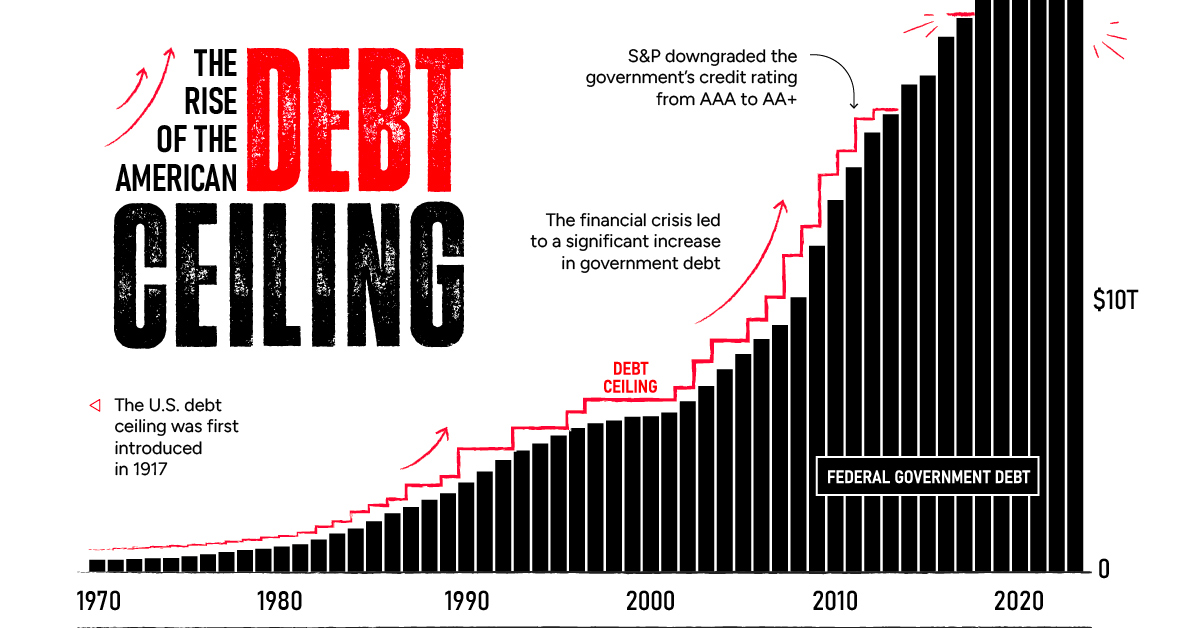
Charting the Rise of America’s Debt Ceiling
Every few years the debt ceiling standoff puts the credit of the U.S. at risk.
In January, the $31.4 trillion debt limit—the amount of debt the U.S. government can hold—was reached. That means U.S. cash reserves could be exhausted by June 1 according to Treasury Secretary Janet Yellen. Should Republicans and Democrats fail to act, the U.S. could default on its debt, causing harmful effects across the financial system.
The above graphic shows the sharp rise in the debt ceiling in recent years, pulling data from various sources including the World Bank, U.S. Department of Treasury, and Congressional Research Service.
Familiar Territory
Raising the debt ceiling is nothing new. Since 1960, it’s been raised 78 times.
In the 2023 version of the debate, Republican House Majority Leader Kevin McCarthy is asking for cuts in government spending. However, President Joe Biden argues that the debt ceiling should be increased without any strings attached. Adding to this, the sharp uptick in interest rates have been a clear reminder that rising debt levels can be precarious.
Consider that historically, interest payments on the U.S. debt have been equal to about half the cost of defense. More recently, however, the cost of servicing the debt has risen, and is now almost on par with the defense budget as a whole.
Key Moments In Recent History
Over history, raising the debt ceiling has often been a typical process for Congress.
Unlike today, agreements to raise the debt ceiling were often negotiated faster. Increased political polarization over recent years has contributed to standoffs with damaging consequences.
For instance, in 2011, an agreement was made just days before the deadline. As a result, S&P downgraded the U.S. credit rating from AAA to AA+ for the first time ever. This delay cost an estimated $1.3 billion in extra costs to the government that year.
Before then, the government shut down twice between 1995 and 1996 as President Bill Clinton and Republican House Speaker Newt Gingrich went head-to-head. Over a million government workers were furloughed for a week in late November 1995 before the debt limit was raised.
What Happens Now?
Today, Republicans and Democrats have less than two weeks to reach an agreement.
If Congress doesn’t make a deal the result would be that the government can’t pay its bills by taking on new debt. Payment for federal workers would be suspended, certain pension payments would get stalled, and interest payments on Treasuries would be delayed. The U.S. would default under these conditions.
Three Potential Consequences
Here are some of the potential knock-on effects if the debt ceiling isn’t raised by June 1, 2023:
1. Higher Interest Rates
Typically investors require higher interest payments as the risk of their debt holdings increase.
If the U.S. fails to pay interest payments on its debt and gets a credit downgrade, these interest payments would likely rise higher. This would impact the U.S. government’s interest payments and the cost of borrowing for businesses and households.
High interest rates can slow economic growth since it disincentivizes spending and taking on new debt. We can see in the chart below that a gloomier economic picture has already been anticipated, showing its highest probability since 1983.
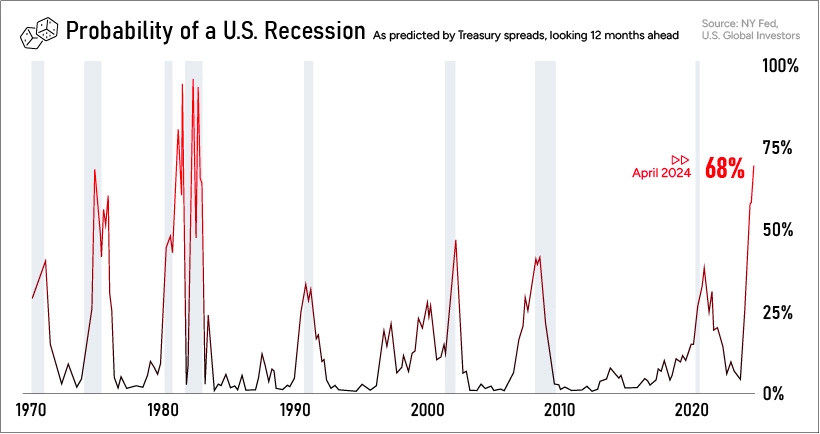
Historically, recessions have increased U.S. deficit spending as tax receipts fall and there is less income to help fund government activities. Additional fiscal stimulus spending can also exacerbate any budget imbalance.
Finally, higher interest rates could spell more trouble for the banking sector, which is already on edge after the collapse of Silicon Valley Bank and Signature Bank.
A rise in interest rates would push down the value of outstanding bonds, which banks hold as capital reserves. This makes it even more challenging to cover deposits, which could further increase uncertainty in the banking industry.
2. Eroding International Credibility
As the world’s reserve currency, any default on U.S. Treasuries would rattle global markets.
If its role as an ultra safe asset is undermined, a chain reaction of negative consequences could spread throughout the global financial system. Often Treasuries are held as collateral. If these debt payments fail to get paid to investors, prices would plummet, demand could crater, and global investors may shift investment elsewhere.
Investors are factoring in the risk of the U.S. not paying its bondholders.
As we can see this in the chart below, U.S. one-year credit default swap (CDS) spreads are much higher than other nations. These CDS instruments, quoted in spreads, offer insurance in the event that the U.S. defaults. The wider the spread, the greater the expected risk that the bondholder won’t be paid.
The US now has higher credit risk than Mexico, Greece, and Brazil pic.twitter.com/je4klBvHZ6
— Genevieve Roch-Decter, CFA (@GRDecter) May 11, 2023
Additionally, a default could add fuel to the perception of global de-dollarization. Since 2001, the USD has slipped from 73% to 58% of global reserves.
Since Russia’s invasion of Ukraine led to steep financial sanctions, China and India are increasingly using their currencies for trade settlement. President of Russia Vladimir Putin says that two-thirds of trade is settled in yuan or roubles. Recently, China has also entered non-dollar agreements with Brazil and Kazakhstan.
3. Financial Sector Turmoil
Back at home, a debt default would hurt investor confidence in the U.S. economy. Coupled with already higher interest rates impacting costs, financial markets could see added strain. Lower investor demand could depress stock prices.
Is the Debt Ceiling Concept Flawed?
Today, U.S. government debt stands at 129% of GDP.
The annualized cost of servicing this debt has jumped an estimated 90% compared to 2011, driven by increasing debt and higher interest rates.
Some economists argue that the debt ceiling helps keep the government more fiscally responsible. Others suggest that it’s structured poorly, and that if the government approves a level of spending in its budget, that debt ceiling increases should come more automatically.
In fact, it’s worth noting that the U.S. is one of the few countries worldwide with a debt ceiling.
-
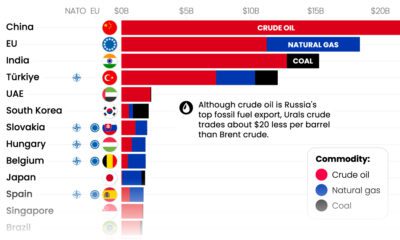
 Energy2 weeks ago
Energy2 weeks agoWho’s Still Buying Russian Fossil Fuels in 2023?
-

 VC+5 days ago
VC+5 days agoWhat’s New on VC+ in July
-

 Investor Education4 weeks ago
Investor Education4 weeks agoVisualizing BlackRock’s Top Equity Holdings
-

 Technology2 weeks ago
Technology2 weeks agoMeet the Competing Apps Battling for Twitter’s Market Share
-

 Public Opinion18 hours ago
Public Opinion18 hours agoHow Do Chinese Citizens Feel About Other Countries?
-

 Markets4 weeks ago
Markets4 weeks agoVisualizing Every Company on the S&P 500 Index
-

 Economy2 weeks ago
Economy2 weeks agoVisualizing 1 Billion Square Feet of Empty Office Space
-
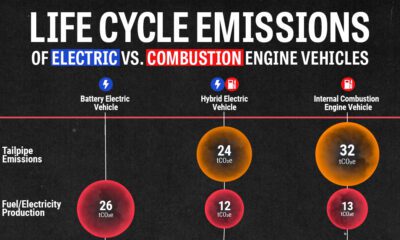
 Green4 weeks ago
Green4 weeks agoLife Cycle Emissions: EVs vs. Combustion Engine Vehicles

